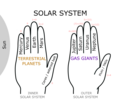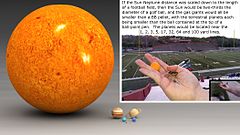Berkas:Solar System Hand Mnemonic.png

Ukuran pratayang ini: 672 × 600 piksel. Resolusi lainnya: 269 × 240 piksel | 538 × 480 piksel | 860 × 768 piksel | 1.147 × 1.024 piksel | 2.294 × 2.048 piksel | 2.800 × 2.500 piksel.
Ukuran asli (2.800 × 2.500 piksel, ukuran berkas: 309 KB, tipe MIME: image/png)
Riwayat berkas
Klik pada tanggal/waktu untuk melihat berkas ini pada saat tersebut.
| Tanggal/Waktu | Miniatur | Dimensi | Pengguna | Komentar | |
|---|---|---|---|---|---|
| terkini | 9 Januari 2013 22.49 |  | 2.800 × 2.500 (309 KB) | Tdadamemd | Reloading latest edit with moon count. |
| 9 Januari 2013 11.29 |  | 2.800 × 2.500 (309 KB) | Tdadamemd | Listed in red are the number of moons for each planet and dwarf planet. Each is broken out into two sets, with the first being the number of large moons that have been rounded by hydrostatic equilibrium, and the second number is the remainder of known ... | |
| 9 Januari 2013 08.35 |  | 2.800 × 2.500 (292 KB) | Tdadamemd | Identifying the left hand as representing the inner solar system, and the right hand as the outer solar system. | |
| 9 Januari 2013 08.03 |  | 2.800 × 2.500 (277 KB) | Tdadamemd | Changing '&' to '/', because the previous notation seemed to indicate that Ceres was not part of the asteroid belt and that Pluto was not a TNO. | |
| 7 Januari 2013 08.03 |  | 2.800 × 2.500 (280 KB) | Tdadamemd | User created page with UploadWizard |
Penggunaan berkas
Halaman berikut menggunakan berkas ini:
Penggunaan berkas global
Wiki lain berikut menggunakan berkas ini:
- Penggunaan pada en.wikipedia.org
